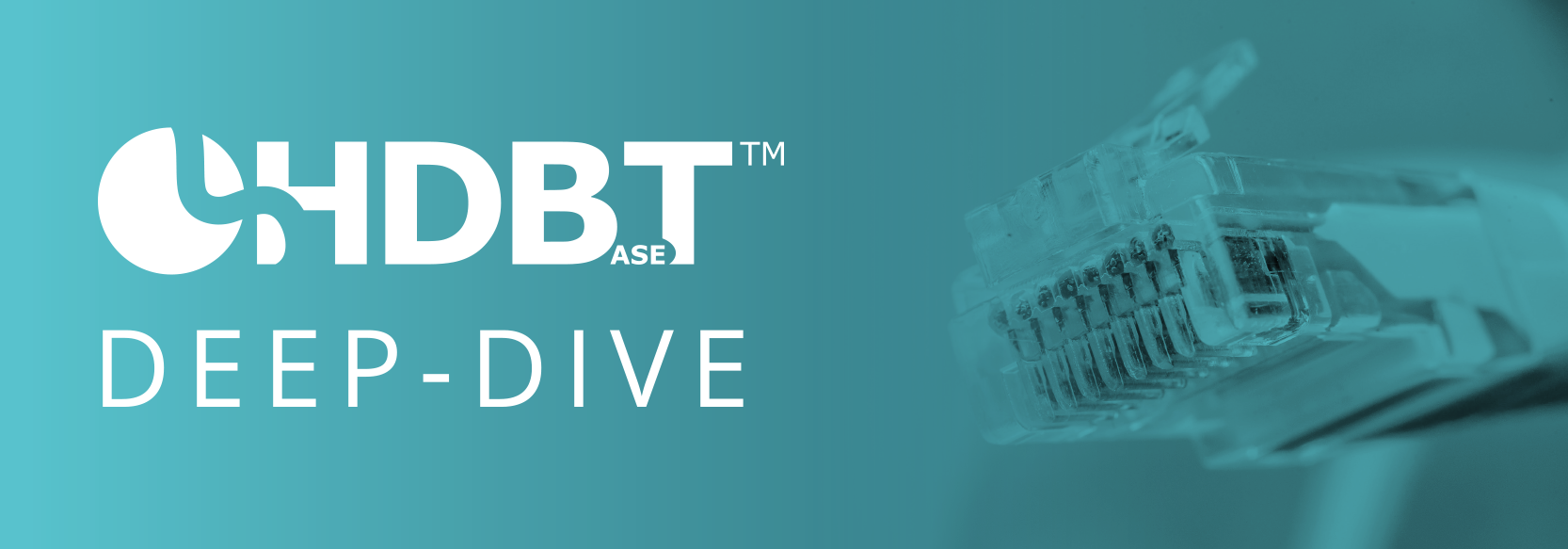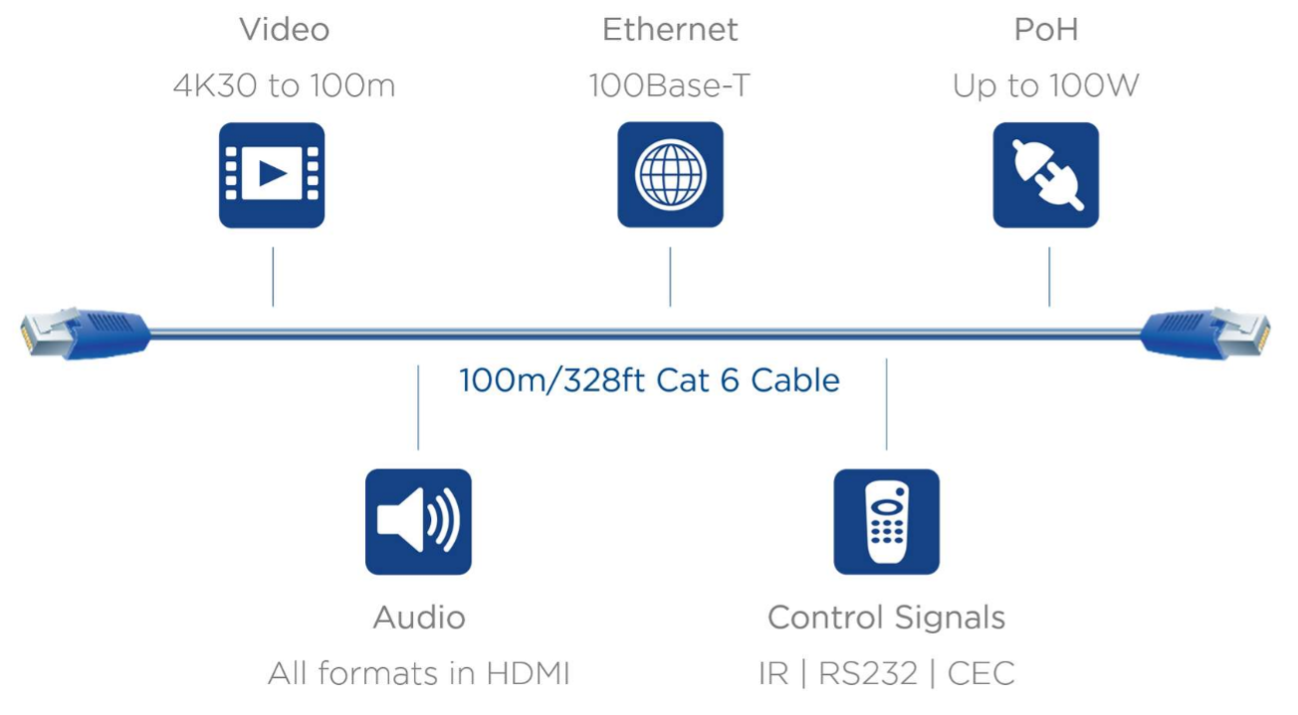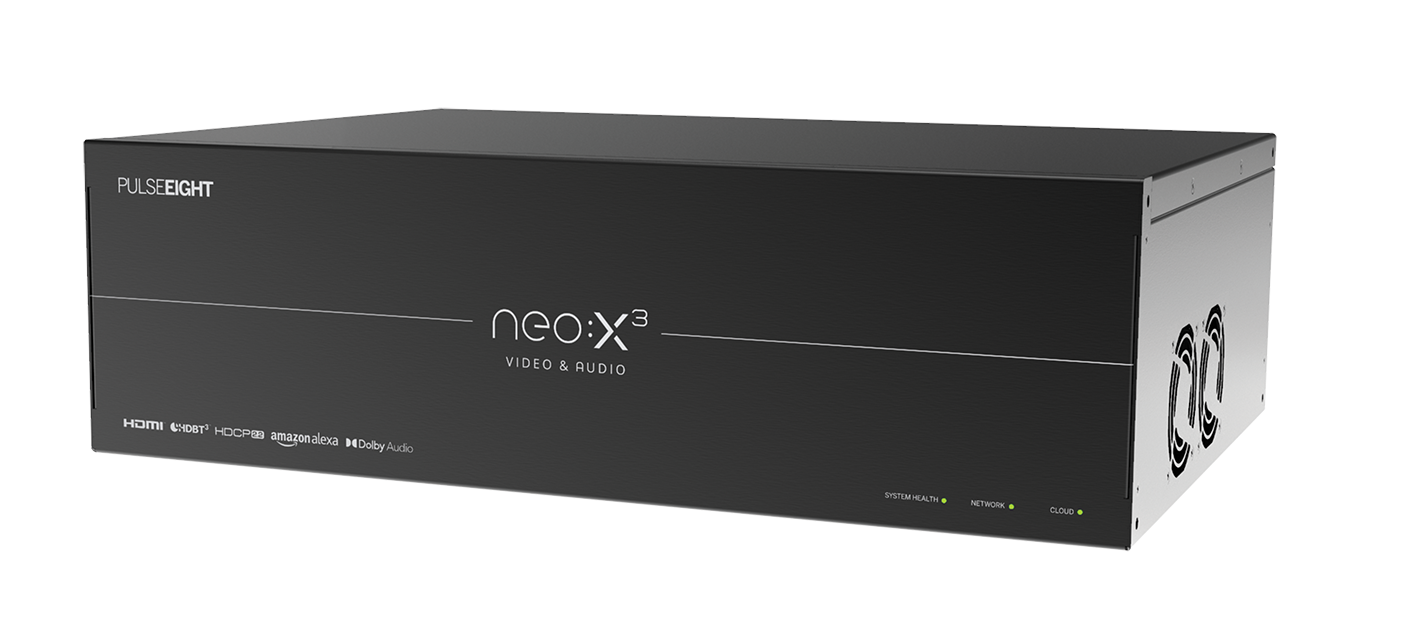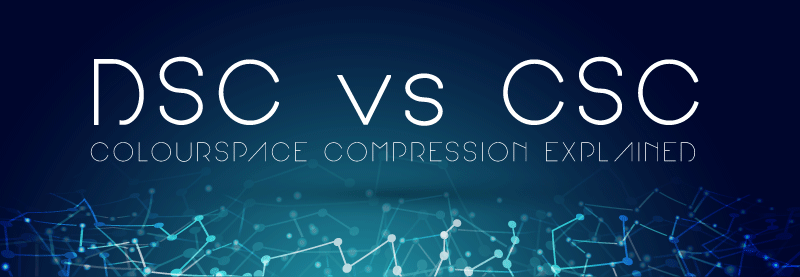WHITEPAPER
HDBaseT Deep-dive
MAY 2022
In this blog, our Business Development Director, Jonathan Regalado-Hawkey discusses the history of HDBaseT technology as well as the benefits of each revision.
Estimated Reading Time: 4 minutes, 40 seconds

Firstly, let’s look at a very brief history of HDBaseT…
It’s fair to say that since its release in 2010, HDBaseT™ has revolutionised the Audio/Video distribution market by providing a plug-and-play connectivity able to converge and distribute different interfaces, through a single category cable up to 100m (328ft). This was truly the first open-standard technology able to extend uncompressed 4K video to such distances!
Since then, over 200 companies have joined the HDBaseT™ Alliance and millions of products have been installed in residential and professional AV distribution applications around the world.
HDBaseT™ 1.0 was the first to enable transmission of uncompressed ultra-high-definition (UHD) video, audio, control and power (up to 100W), with near-zero latency, over a single LAN cable. We’ll be discussing the “magic” behind the technology in a separate blog but for now, let’s just say that it was truly groundbreaking technology back then and even to this day!

Since its inception, HDBaseT™ 1.0 has been capable of supporting a bit exact pass-through for all maximum video resolutions available under the various HDMI® 1.x specifications (HDMI® 2.0 was not available yet). Anything from 1080p@60Hz to 4K@30Hz is supported uncompressed – as well as audio formats.
If that wasn't enough, you can simultaneously send ethernet (up to 100Mbps) control signals such as IR, RS232 and HDMI-CEC and provide operating power to the attached device at the other end.
Over the years, Pulse-Eight have successfully released several award-winning and cost-effective HDBaseT™ 1.0 extension products specifically targeted for the residential market and some of our most popular products continue to utilise this technology.
"Pulse-Eight matrices are unique in their ability to seamlessly route audio so that “the audio always follows video"
Following the success of HDBaseT 1.0, came the release of HDBaseT 2.0...
This wasn't a major breakthrough in terms of video resolution. However, from an audio perspective, it added the capability of supporting Audio Return Channel (ARC). This feature allows audio from a television, streaming an over-the-top (OTT) service like Netflix, to be sent to an AVR or amplifier connected in a different room. ARC has now become a “must” for modern video matrices, although consumers are at times limited by some hardware constraints.
Pulse-Eight matrices are unique in their ability to seamlessly route audio so that “the audio always follows video”. Whether video is being routed to the matrix or streamed directly to the TV, the matrix is automatically extracting the correct audio – either through de-embedding or HDMI® ARC - to match the video on the display.
One interesting ‘hidden feature’ of HDBaseT™ 2.0, that I feel distinguishes it from the previous HDBaseT™ 1.0, is the transmission signal itself, which has an extra layer of reliability and immunity from external noise. This is particularly important as when having multiple cables bundled together in an installation allows the possibility for technically using low-latency, mezzanine compression such as Display Stream Compression (DSC) for sending 4K@60Hz without any latency on the video.
For more information on DSC, be sure to read my white paper: To DSC or CSC? which explains why we should remain vigilant against lower compression techniques. Click below...
Anyway, back to HDBaseT…
Pulse-Eight has utilised HDBaseT™ 2.0 technology to create some of the most advance audio/ video matrices for the residential market, such as the award winning NeoX+, Neo XMR and Neo XSR range, supporting 4K@60Hz (using DSC) and ARC.

Now, let’s move onto the latest specification of HDBaseT, version 3.0.
This new version really is a game-changer for the industry… it’s the only solution in the market today (at least known to me) able to support all video resolutions and formats of HDMI® 2.0 (up to 18Gbps) including 4K@60Hz/4:4:4 over a single category cable up to 100m UNCOMPRESSED!
By having a “no compression” approach, you’re less likely to run into edge cases with a particular resolution not being supported – after all, it is “bit perfect” and what goes in, goes out. A perfect example of this is that with HDBaseT™ 3.0 we are now able to support DolbyVision at 4K@60Hz, something that wasn't possible with previous versions of HDBaseT.
Other worthy upgrades in this standard are the ability to send 1Gps ethernet (10x the previous 100Mbps) and support for enhanced-ARC (eARC).
It’s fair to say that the technology does come with its challenges. Doubling the bandwidth means that its physical channel (i.e. the cable) needs to meet certain requirements. For example, if you want to achieve the full 100m run, you must consider a U/FTP CAT6A cable. Shorter distances are still achievable with lower grade cables however, new installations will certainly benefit from future-proofing their installations with CAT6A cabling.
HDBaseT™ Alliance have put together a useful one-page table showing what video resolutions and formats are supported by each standard.
This can be found
here.
Pulse-Eight, yet again, is at the forefront of innovation and has upgraded several of its popular matrix range products to support HDBaseT™ 3.0. This is expected to be released later in the year.

Further to this, Pulse-Eight actively participates in several working standards and has been working closely with the HDBaseT™ Alliance as part of the Audiovisual Working Group. We are always keen to promote good practices and push the industry forward.
As an example, one of our recommendations to the HDBaseT™ Alliance was the need to tighten the use of compliant Power-over-HDBaseT (PoH) when sending power. This is because it strictly removes the possibility of a rogue vendor bypassing this requirement and using a non-standardised, proprietary Power-over-Cable (PoC) solution as some HDBaseT products do today. This is critical as PoC solutions are a known major interoperability and safety issue and so fixing this loophole is a big win for both installers and consumers.
To summarise, HDBaseT™ has been a technology that revolutionised the AV industry for residential installations and one that will continue to play a major part in the years to come with the latest standard. Here at Pulse-Eight, we are proud to have created some of the most advanced AV distribution products to date and will continue to innovate further products using this technology.
Thanks for reading!
Jonathan Regalado-Hawkey
BUSINESS DEVELOPMENT DIRECTOR
Jonathan has over 14 years experience in the semiconductor and ProAV industry. He has participated in all aspects of technical system architecture, customer support and sales. Over the years, he has developed long-term business relationships and is well regarded amongst industry luminaries.



